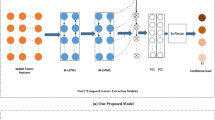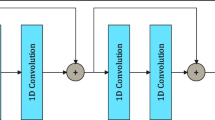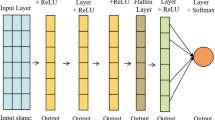Abstract
Automatic Modulation Classification holds significant importance in the realm of wireless communication systems. The proliferation of modulation schemes, coupled with the escalating complexity of channel environments, necessitates a heightened accuracy in discerning modulated signals. Traditional methods struggle to effectively classify this array of modulation schemes. In response, this paper advocates the employment of deep learning techniques for precise modulation classification. A deep learning architecture is introduced, comprising a convolutional neural network, and a long short-term memory neural network leveraging the power of transfer learning. The convolutional neural network adeptly extracts spatial features from the received signal, while a bidirectional long short-term memory neural network is engineered to capture temporal features. Transfer learning is employed for efficient parameter sharing. Empirical evaluations were conducted using the RadioML2016.10b dataset, affirming the efficacy of the proposed mechanism.















Similar content being viewed by others
Explore related subjects
Discover the latest articles, news and stories from top researchers in related subjects.Availability of Data and Materials
Dataset used in the experiments can be found on: https://www.deepsig.ai/datasets.
References
Wang Y, Liu M, Yang J, Gui G. Data-driven deep learning for automatic modulation recognition in cognitive radios. IEEE Trans Veh Technol. 2019;68(4):4074–7. https://doi.org/10.1109/TVT.2019.2900460.
Su W, Xu JL, Zhou M. Real-time modulation classification based on maximum likelihood. IEEE Commun Lett. 2008;12(11):801–3. https://doi.org/10.1109/LCOMM.2008.081107.
Teng C-F, Chou C-Y, Chen C-H, Wu A-Y. Accumulated polar feature-based deep learning for efficient and lightweight automatic modulation classification with channel compensation mechanism. 2020.
Dobre OA, Abdi A, Bar-Ness Y, Su W. Survey of automatic modulation classification techniques: classical approaches and new trends. IET Commun. 2007. https://doi.org/10.1049/iet-com:20050176.
O’Shea TJ, Roy T, Clancy TC. Over-the-air deep learning based radio signal classification. IEEE J Sel Top Signal Process. 2018;12(1):168–79. https://doi.org/10.1109/JSTSP.2018.2797022. arXiv:1712.04578.
Peng S, Jiang H, Wang H, Alwageed H, Zhou Y, Sebdani MM, Yao YD. Modulation classification based on signal constellation diagrams and deep learning. IEEE Trans Neural Netw Learn Syst. 2019;30(3):718–27. https://doi.org/10.1109/TNNLS.2018.2850703.
Zhou R, Liu F, Gravelle CW. Deep learning for modulation recognition: a survey with a demonstration. IEEE Access. 2020. https://doi.org/10.1109/ACCESS.2020.2986330.
O’Shea TJ, Corgan J, Clancy TC. Convolutional radio modulation recognition networks. Commun Comput Inf Sci. 2016;629:213–26. https://doi.org/10.1007/978-3-319-44188-7_16.
Peng S, Jiang H, Wang H, Alwageed H, Yao YD. Modulation classification using convolutional neural network based deep learning model. In: 2017 26th wireless and optical communication conference, WOCC 2017. 2017. https://doi.org/10.1109/WOCC.2017.7929000.
Rajendran S, Meert W, Giustiniano D, Lenders V, Pollin S. Deep learning models for wireless signal classification with distributed low-cost spectrum sensors. IEEE Trans Cogn Commun Netw. 2018;4(3):433–45. https://doi.org/10.1109/tccn.2018.2835460.
Daldal N, Cömert Z, Polat K. Automatic determination of digital modulation types with different noises using convolutional neural network based on time-frequency information. Appl Soft Comput J. 2020. https://doi.org/10.1016/j.asoc.2019.105834.
Xiao Y, Liu W, Gao L. Radar signal recognition based on transfer learning and feature fusion. Mob Netw Appl. 2019. https://doi.org/10.1007/s11036-019-01360-1.
Hu S, Pei Y, Liang PP, Liang YC. Deep neural network for robust modulation classification under uncertain noise conditions. IEEE Trans Veh Technol. 2020;69:564–77. https://doi.org/10.1109/TVT.2019.2951594.
Huang S, Dai R, Huang J, Yao Y, Gao Y, Ning F, Feng Z. Automatic modulation classification using gated recurrent residual network. IEEE Internet Things J. 2020. https://doi.org/10.1109/jiot.2020.2991052.
Nie J, Zhang Y, He Z, Chen S, Gong S, Zhang W. Deep hierarchical network for automatic modulation classification. IEEE Access. 2019;7:94604–13. https://doi.org/10.1109/ACCESS.2019.2928463.
Huynh-The T, Hua CH, Kim JW, Kim SH, Kim DS. Exploiting a low-cost CNN with skip connection for robust automatic modulation classification. In: IEEE wireless communications and networking conference, WCNC, vol. 2020-May 2020. https://doi.org/10.1109/WCNC45663.2020.9120667.
Chen S, Zhang Y, He Z, Nie J, Zhang W. A novel attention cooperative framework for automatic modulation recognition. IEEE Access. 2020;8:15673–86. https://doi.org/10.1109/ACCESS.2020.2966777.
Zhang H, Wang Y, Xu L, Aaron Gulliver T, Cao C. Automatic modulation classification using a deep multi-stream neural network. IEEE Access. 2020;8:43888–97. https://doi.org/10.1109/ACCESS.2020.2971698.
Wu X, Wei S, Zhou Y, Liao F. TSN-A: an efficient deep learning model for automatic modulation classification based on intra-class confusion reduction of modulation families. IEEE Commun Lett. 2022;26(12):2964–8. https://doi.org/10.1109/LCOMM.2022.3210586.
Elsagheer MM, Ramzy SM. A hybrid model for automatic modulation classification based on residual neural networks and long short term memory. Alex Eng J. 2023;67:117–28. https://doi.org/10.1016/j.aej.2022.08.019.
Zhang D, Lu Y, Li Y, Ding W, Zhang B, Xiao J. Frequency learning attention networks based on deep learning for automatic modulation classification in wireless communication. Pattern Recognit. 2023;137: 109345. https://doi.org/10.1016/j.patcog.2023.109345.
Li Z, Zhang W, Wang Y, Li S, Sun X. A lightweight multi-feature fusion structure for automatic modulation classification. Phys Commun. 2023;61: 102170. https://doi.org/10.1016/j.phycom.2023.102170.
Wang N, Liu Y, Ma L, Yang Y, Wang H. Multidimensional CNN-LSTM network for automatic modulation classification. Electronics. 2021;10(14):1649.
Ramjee S, Ju S, Yang D, Liu X, Gamal AE, Eldar YC. Fast deep learning for automatic modulation classification. arXiv preprint arXiv:1901.05850 2019;
Liu X, Yang D, El Gamal A. Deep neural network architectures for modulation classification. In: Conference record of 51st asilomar conference on signals, systems and computers, ACSSC 2017, vol. 2017-October. 2018. pp. 915–919. https://doi.org/10.1109/ACSSC.2017.8335483.
O’Shea TJ, West N. Radio machine learning dataset generation with GNU radio. In: Proceedings of the GNU radio conference. 2016. https://scholar.google.com/citations?view_op=view_citation&hl=en &user=4S4GyXYAAAAJ &citation_for_view=4S4GyXYAAAAJ:9Nmd_mFXekcC
Gao J, Yi X, Zhong C, Chen X, Zhang Z. Deep learning for spectrum sensing. IEEE Wirel Commun Lett. 2019;8(6):1727–30. https://doi.org/10.1109/LWC.2019.2939314. arXiv:1909.02730.
Szegedy C, Liu W, Jia Y, Sermanet P, Reed S, Anguelov D, Erhan D, Vanhoucke V, Rabinovich A. Going deeper with convolutions. In: Proceedings of the IEEE computer society conference on computer vision and pattern recognition, vol. 07-12-June-2015. 2015. pp. 1–9. https://doi.org/10.1109/CVPR.2015.7298594.
West NE, O’Shea T. Deep architectures for modulation recognition. In: 2017 IEEE international symposium on dynamic spectrum access networks, DySPAN 2017. 2017. https://doi.org/10.1109/DySPAN.2017.7920754.
LeCun Y, Bottou L, Bengio Y, Haffner P. Gradient-based learning applied to document recognition. Proc IEEE. 1998;86(11):2278–323. https://doi.org/10.1109/5.726791.
Peng Q, Gilman A, Vasconcelos N, Cosman PC, Milstein LB. Robust deep sensing through transfer learning in cognitive radio. IEEE Wirel Commun Lett. 2020;9(1):38–41. https://doi.org/10.1109/LWC.2019.2940579. arXiv:1908.00658.
Shi W, Liu D, Cheng X, Li Y, Zhao Y. Particle swarm optimization-based deep neural network for digital modulation recognition. IEEE Access. 2019;7:104591–600. https://doi.org/10.1109/access.2019.2932266.
He K, Zhang X, Ren S, Sun J. Deep residual learning for image recognition. In: Proceedings of the IEEE computer society conference on computer vision and pattern recognition, vol. 2016-December. 2016. pp. 770–778. https://doi.org/10.1109/CVPR.2016.90
Acknowledgements
Not applicable.
Funding
No external funding has been received for this research from any international or national body.
Author information
Authors and Affiliations
Contributions
Surendra Solanki carried out the experiment, wrote the manuscript. Banalaxmi Brahma and Yadvendra Pratap Singh reviewed and updated the manuscript.
Corresponding author
Ethics declarations
Conflict of interest
Not applicable.
Ethics approval and consent to participate
Not applicable.
Consent for publication
Not applicable.
Additional information
Publisher's Note
Springer Nature remains neutral with regard to jurisdictional claims in published maps and institutional affiliations.
Rights and permissions
Springer Nature or its licensor (e.g. a society or other partner) holds exclusive rights to this article under a publishing agreement with the author(s) or other rightsholder(s); author self-archiving of the accepted manuscript version of this article is solely governed by the terms of such publishing agreement and applicable law.
About this article
Cite this article
Solanki, S., Brahma, B. & Singh, Y.P. Automatic Modulation Classification for CR Using Deep Learning. SN COMPUT. SCI. 5, 1061 (2024). https://doi.org/10.1007/s42979-024-03410-2
Received:
Accepted:
Published:
DOI: https://doi.org/10.1007/s42979-024-03410-2




